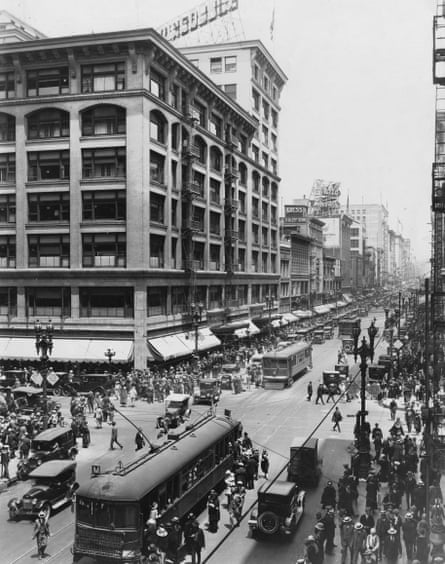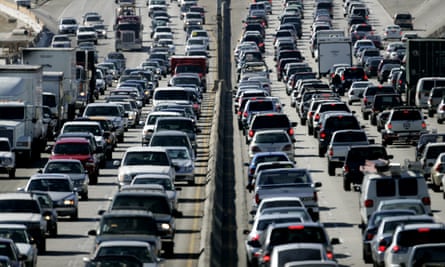The last train on the last line of greater Los Angeles’ Pacific Electric streetcar network made its last run on 9 April 1961. You can see the final days of this once-robust public transport system for yourself in the short film Ride the Last of the Big Red Cars.
This footage of the remaining “red cars” (as the Pacific Electric’s fleet was commonly known) strikes an elegiac tone, especially to modern Angelenos. They have little more than history books and the rose-tinted memories of old-timers from which to reconstruct the heyday of urban rail in Los Angeles, a city which spent decades after the disappearance of the red cars saddled with the reputation as a car-dependent, smog-choked, freeway-bound yet traffic-paralysed dystopia – and not without cause.
The Pacific Electric, along with the “yellow cars” of the Los Angeles Railway, made up the young southern California metropolis’ rail transit system throughout the first half of the 20th century. At the peak of their combined coverage and accessibility, they made Los Angeles’ public transportation the best in the country, if not the world. Why, then, did they vanish from the cityscape by the mid-1960s, their tracks yanked from the streets and their rolling stock tossed on the heap (or sent to Argentina)? What forces could have replaced the proud red and yellow cars with a fleet of plain old buses, the likes of which so many Angelenos still disdain today? It looks, to some, like the work of a conspiracy.
Between 1938 and 1950, one company purchased and took over the transit systems of more than 25 American cities. Their name, National City Lines, sounded innocuous enough, but the list of their investors included General Motors, the Firestone Tire and Rubber Company, Standard Oil of California, Phillips Petroleum, Mack Trucks, and other companies who stood to benefit much more from a future running on gasoline and rubber than on electricity and rails. National City Lines acquired the Los Angeles Railway in 1945, and within 20 years diesel buses – or indeed private automobiles – would carry all the yellow cars’ former passengers. Does that strike you as a coincidence?
It didn’t look that way to the Federal District Court of Southern California, which in 1947 indicted nine corporations and seven individuals on counts of “conspiring to acquire control of a number of transit companies, forming a transportation monopoly” and “conspiring to monopolise sales of buses and supplies to companies owned by National City Lines” in violation of the 1890 Sherman Antitrust Act. The conviction came in 1949, with GM, Firestone, Standard Oil of California, Phillips Petroleum, and Mack Trucks found guilty and subsequently slapped on the wrists. (GM paid a fine of $5,000.)
The 1988 film Who Framed Roger Rabbit? set its story in the year 1947, pitting workaday Los Angeles private detective Eddie Valiant against the villain Judge Doom, a cadaverous, black-clad personification of all these backroom-dealing companies. In the film’s final act, Judge Doom reveals to Valiant his plot to build “eight lanes of shimmering cement running from here to Pasadena”.

And who, asks Valiant, would drive on such a monstrosity when they could ride the Pacific Electric – “the best public transportation system in the world” – for five cents? “Oh, they’ll drive,” replies Judge Doom. “They’ll have to. You see, I bought the Red Car so I could dismantle it.”
The notion of a plot not just to monopolise the bus-and-supply market but to deliberately destroy the rail transit systems of urban America only came to wide attention in 1974, when a young anti-trust attorney named Bradford Snell argued to the US Senate that the introduction of “noisy, foul-smelling buses turned earlier patrons of the high speed rail systems away from public transit, and, in effect, sold millions of private automobiles” – and that “General Motors’ destruction of electric transit systems across the country left millions of urban residents without an attractive alternative to automotive travel”.
Snell called upon testimony from Los Angeles mayor Tom Bradley, which he gave in absentia but in unambiguous terms, describing GM as having, through its subsidiaries, “scrapped the Pacific Electric and Los Angeles streetcar systems, leaving the electric train system totally destroyed.” GM, in the face of such harsh accusations, made no recorded public response except to admit to its investment in American City Lines, a company with which National City Lines merged in 1946.
It didn’t matter that National City Lines, even with GM’s money, never actually got around to buying the Pacific Electric system like they bought the Los Angeles Railway, nor that the public Los Angeles Metropolitan Transit Authority oversaw the last of its dismantling; the “Great American Streetcar Scandal” was already well on its way to the public consciousness.
In the second half of the 20th century, Los Angeles had little or nothing in the way of rapid transit infrastructure, and certainly nothing of the efficiency that car-owning Angelenos felt could compare to simply driving themselves. “Transit had been reduced largely to poor service on decrepit buses,” writes Brian Ladd in Autophobia: Love and Hate in the Automotive Age. “Why had American mass transit, especially the streetcars that were once the envy of the world, been so thoroughly dismantled? How could Americans have been so shortsighted?”
The answer begins with the very nature of the Pacific Electric and the Los Angeles Railway: neither began as the sort of publicly owned and operated transit systems we expect in the 21st century, but as mere tools in a larger, for-profit, real-estate development development operation. Both entered service in 1901, as the descendants of the electric trolleys that first appeared in Los Angeles in its booming 1880s, under the ownership of magnate and Southern California booster Henry E Huntington. Unprofitable in and of themselves, Huntington’s streetcars grew into such an extensive system in large part because he needed them to take newly minted Angelenos out to far-flung tracts where they could purchase a lot of their own – from the massively land-owning Huntington himself. The streetcar system itself, in other words, was a kind of conspiracy.
Just as the Pacific Electric-connected land around Los Angeles sold off and built up, the automobile craze swept through America. “Los Angeles embraced the automobile at a much faster rate than in other places around the country,” says Ethan Elkind, author of Railtown: The Fight for the Los Angeles Metro Rail and the Future of the City, “in part because of the flat terrain and nice climate, but also because the previous streetcar system subdivisions ironically lent themselves well to automobile driving as an appealing alternative to the streetcars, at least in the beginning when the population was small and traffic was minimal.” And when even 10% of Los Angeles’ population got behind the wheel, their presence so slowed the streetcars, which lacked their own lanes, that they could no longer make their schedules, and their level of service declined overall.
All across America, writes Ladd, streetcar transit “had been expected to pay for itself, but after ridership ceased to grow in the 1920s, the private franchises that operated most transit systems were unable to make money under the regulations imposed on them by local governments. As they cut service, former passengers bought cars, ridership and fare revenue declined further, and a death spiral ensued, leaving cities to pick up the bankrupt pieces and offer grudging subsidies to keep a bare-bones system running,” even as, due to their much lower infrastructure and operating costs, “transit companies across the country, whoever controlled them, were seeking to switch many lines to the promising new technology of motor buses.”

This conversion process had begun well before General Motors and the others involved in National City Lines started buying up streetcar systems. By the end of the 1920s, about 20% of the country’s cities used buses only, and even in 1923 the Pacific Electric had put their order in for buses to run instead of trains on some routes. NCL did indeed replace more trains with buses after purchasing the financially troubled Los Angeles Railway in 1945, but that just continued a process that had begun much earlier, and which took place similarly across the country and indeed the world. Streetcars vanished in almost every metropolitan area in the United States, and only in 10% of those cases did NCL have anything to do with it.
One can confidently accuse General Motors and their National City Lines of nothing worse than scheming to profit from a trend already in motion. As far as who took away the streetcars, more of the blame lies at the feet of the United States federal government, whose suite of anti-urban post-war policies from building freeways on a colossal scale to incentivise single-family home ownership – not to mention the local voters who both refused to bring the Los Angeles’ rail systems under public ownership in the 1920s and repeatedly shot down rapid-transit proposals in favour of improved automotive infrastructure for decades thereafter.
Yet even without strong evidence of a car company-driven streetcar-dismantling conspiracy, we can see all around us, especially in America, that just the well-documented social and economic forces acting on cities in the mid-20th century – an obsession with cars and the consequent rise of auto-centric planning along with “white flight” from the central cities and the suburban living that the Pacific Electric itself encouraged – did more damage than could even the most malevolent cabal.
So why does the Great American Streetcar Scandal live on in the hearts and minds of Los Angeles? “Angelenos are rightfully frustrated by being forced to buy cars and sit in traffic to get around, and many feel like this situation was foisted on them without the consent of residents,” says Elkind. “It’s easy to blame car companies because they’re the logical economic beneficiary of this car-oriented system. But the reality is more complex, and if there’s any conspiracy here, it’s on the part of local officials who kept approving sprawling subdivisions that have led to the present inefficient land use patterns.”
Or, in the words of Judge Doom, to strings of “gas stations, inexpensive motels, restaurants that serve rapidly prepared food. Tire salons, automobile dealerships and wonderful, wonderful billboards reaching as far as the eye can see. My god, it’ll be beautiful.”
Does your city have a little-known story that made a major impact on its development? Please share it in the comments below or on Twitter using #storyofcities

Comments (…)
Sign in or create your Guardian account to join the discussion